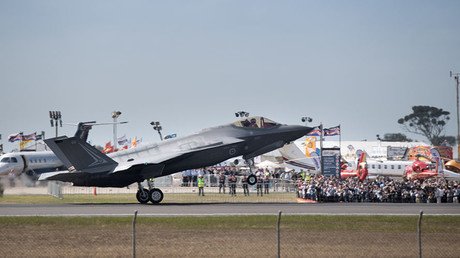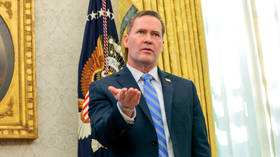Australia & China on Pacific Ocean collision course & no one’s talking about it

Australia has ramped up anti-Chinese rhetoric, challenging Beijing over its growing influence in the Pacific. Trump’s pick for ambassador to Australia, stalwart anti-Chinese Adm. Harris, paints a clear picture of what’s to come.
In 1900, then-Senator Albert Beveridge famously said to lawmakers in Washington that “the power that rules the Pacific, is therefore the power that rules the world.”
As recent developments will demonstrate, this imperialist sentiment continues over 100 years later to the present day. The battle for control over the Pacific is taking place right before our very eyes and is placing both Australia and China in a precariously confrontational position, though the mainstream media refuses to pay due focus to the issue.
Australia’s recent attacks on China
It all went downhill at the end of last year when Australia went out of its way to accuse China of “foreign interference,” with Prime Minister Malcolm Turnbull stating that Australia would “stand up” to China against meddling in its national affairs.
Later, Australia strained its relationship with China even further, after Australia’s Minister of International Development Concetta Fierravanti-Wells accused China of building “roads to nowhere” in the Pacific. She also claimed that China was constructing “useless buildings” throughout the region, and berated it for allegedly loading Pacific Island countries with mounting debt that they cannot afford to pay.
Not surprisingly, these verbal attacks were not necessarily received well by the countries that matter the most. Samoan Prime Minister Tuilaepa Sailele found Australia’s critical remarks against China “insulting,” saying he did “not really know that Australia is able to finance the kind of assistance provided by China.”
At the end of last year, China signed a series of infrastructure deals with Papua New Guinea (PNG), as part of China’s ‘One Belt, One Road’ initiative. Australia immediately responded negatively to this development, with opposition MPs voicing their concern that Australia had lost its “leadership role” throughout the Pacific – whatever that means.
In a pre-emptive attempt to stifle China’s relationship with PNG, Australia agreed to sponsor PNG’s ambitious plan to host the APEC summit set to take place this year. In other words, Australia’s only real desire to involve itself further in the region is to combat China’s expanding influence in the region. As of right now, Australia still maintains its position as the region’s largest donor.
China’s growing friendships in the Pacific has rattled Australia in more ways than one. In September 2016, Fiji’s Prime Minister Bainimarama called for New Zealand and Australia to be kicked out of the Pacific Islands Forum as “they are not Pacific Islanders,” with strong indications that Fiji would rather they be replaced by China instead.
Australia’s close friend and ally, New Zealand, for its part, just this past week went on a tour of the Pacific as well, pledging money left, right and center. As noted by the Samoan Observer, it was no secret that New Zealand, too, is equally concerned by China’s growing role in the region.
“Prior to their arrival on Sunday evening, the New Zealand government had been talking about re-sharpening their focus on the Pacific amidst concerns about China’s growing dominance,” the paper said.
China’s Belt-Road initiative
The US has long had a containment strategy specifically targeting China, famously dubbed the ‘Pivot to Asia’ strategy under the Obama administration. As a key ally of Washington, it makes sense that Australia holds similar views as to the perceived threat of China’s rise on the global stage.
Make no mistake, however, that Washington’s issue with China’s mounting influence in the region is purely economic. In fact, the Transpacific Partnership Agreement (TPP) was undoubtedly an attempt for the US to unite its transpacific allies against China, so it makes little sense that Trump wanted to discontinue it, given his known animosity towards China prior to his election.
Right now, China is in the process of uniting much of the world under its One Belt, One Road initiative, a monumental project which will endeavor to connect China, Asia, Africa, Europe and the Pacific and largely leave the United States out of its profit-sharing completely.
As it stands, all that is left blocking China from injecting itself into the rest of the global sphere is a chain of islands known as the ‘first island chain’, a term that refers to the Kuril Islands of Russia, the Japanese archipelago, Taiwan, the northern Philippines and Borneo. China has traditionally been blocked from injecting its military influence eastward into the Pacific Ocean by America’s strong control of this chain, but this control is already being challenged.
Just recently, China flew an intelligence aircraft near these southern outlying islands of Japan. Russia is also reportedly looking to build a naval base in the area, which will further complicate Washington’s ability to exert its control over the islands.
China has also allegedly been exercising its air force around Taiwan at least 16 times in the last year or so, demonstrating its intent to one day bring Taiwan to heel and bring it under the control of the “motherland.”
Role of the US
The extent of America’s direct role in this particular debacle is less obvious. Writing in the Asia-Pacific Journal, Andre Vitchek explains that the reason America’s role is less forceful in some Pacific Island nations is because New Zealand, Australia and the US have divided the Pacific between themselves, with New Zealand controlling Polynesia, Australia in charge of Melanesia and the US charged with maintaining Micronesia.
However, in early February, US President Donald Trump said he planned to nominate Admiral Harry B. Harris Jr., the commander of the US Pacific Command and an outspoken critic of China, as ambassador to Australia. This is a man who described China’s artificial island project as “a Great Wall of sand,” and has repeatedly called China’s policy in the South China Sea “provocative and expansionist.” He also openly stated in 2014 that he believes the most volatile and dangerous threat facing the world to be North Korea, a current ally of China. According to the New York Times, Chinese media has already labeled Harris a US hawk.
Unsurprisingly, Harris celebrated Trump’s nomination by immediately advising the United States Congress that Washington should prepare for the possibility of a war with China in the South China Sea, adding that “China’s impressive military build-up could soon challenge the United States across almost every domain.
“Australia is one of the keys to a rules-based international order,” Harris also said. “I look to my Australian counterparts for their assistance, I admire their leadership in the battlefield and in the corridors of power in the world… a key ally of the United States and they have been with us in every major conflict since World War I.”
Just over a week ago, Harris met with Australia’s defense minister in Canberra to discuss the two countries’ “amazing alliance.”
Australia “sleep-walking into confrontation with China”
Speaking in regard to Harris’ appointment, Euan Graham, director of the international security program at the Lowy Institute said what Harris “needs to be aware of is the sensitivity around looking like Australia is doing America’s bidding.”
Unsurprisingly, Australia is viewed as the “right hand of the United States” in the part of the Pacific region under discussion, and it seems overtly likely that Australia is acting in its capacity as an American client state, carrying out America’s interests by vehemently confronting China’s expanding influence.
Perhaps Australia’s recent demeaning remarks towards China are a mark of a change in posture in the Asia-Pacific region and go far beyond that of mere verbal saber-rattling. Former colonial overlord Britain will send a warship from Australia through the South China Sea this month, a direct attempt to provoke and let China know that Australia and its allies will not go down without a fight.
“She’ll be sailing through the South China Sea ... and making it clear our navy has a right to do that,” British Defence Secretary Gavin Williamson reportedly told the Australian.
Whether or not the mainstream media pays this issue the respect it so desperately demands, the reality is that Australia is “sleepwalking into a confrontation with China,” as acclaimed journalist John Pilger described the current conundrum. There’s a reason Australia is playing an increasingly militaristic role in the region, joining in navy and military drills with the United States and its close Asia-Pacific allies. Aside from the fact that Australia has joined in almost every US-led military adventure from Vietnam to Iraq; in 2016, Australian warplanes assisted the US-led coalition in Syria to strike and kill over 60 Syrian troops in direct contravention of international law. Australia is far from a passive player in US-led conflicts, and the pending appointment of the hawkish Harris as ambassador to Australia should be a horrifying sign of things to come.
Darius Shahtahmasebi for RT
Darius Shahtahmasebi is a New Zealand based legal and political analyst. Follow him on Twitter @TVsLeaking
The statements, views and opinions expressed in this column are solely those of the author and do not necessarily represent those of RT.


















